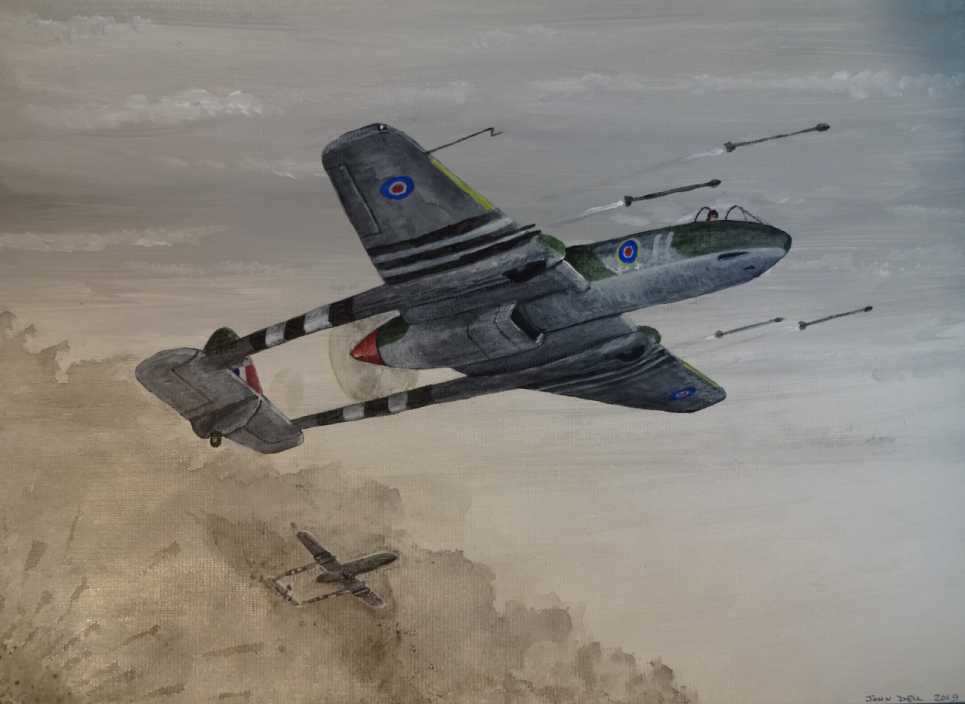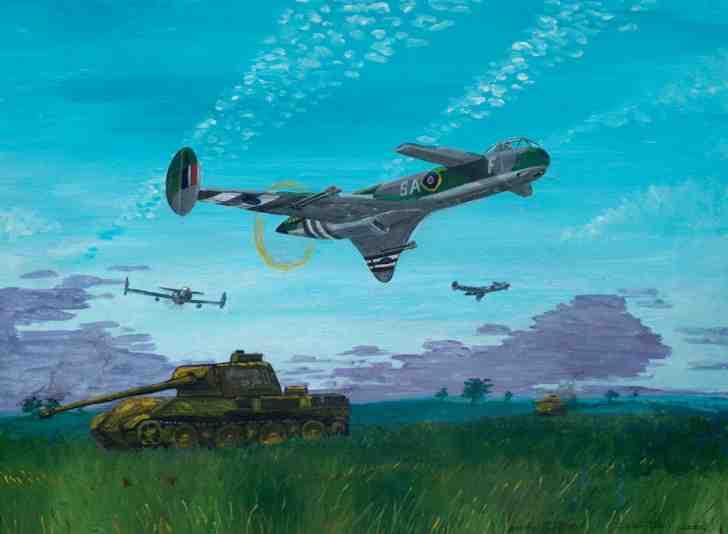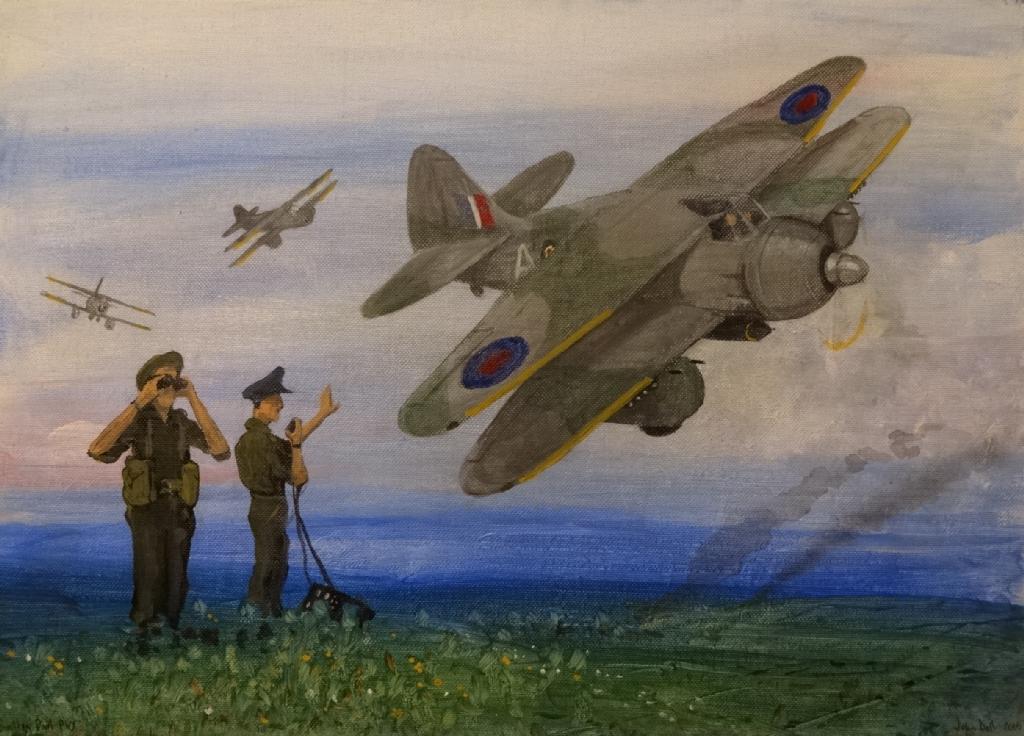Dinger's Aviation Pages
The Boulton Paul Ground Attack Aircraft Projects (P99, P100 and P101).
All images © John Dell
All images © John Dell
The Boulton Paul P99, P100 and P101 were a series of unbuilt project for a ground-attack aircraft to a draft Air Ministry specification (unnumbered) of March 1942. The performance specified by the Air Ministry was not that very high, only 280 mph was asked for, stressing the overriding need was for the accuracy of delivery of its weapons. An armament of multiple large-calibre cannons was to be fitted along with the ability to carry bombs and rockets. It seems that an in service date of January 1944 was hoped for, in time to take part in D-Day and the liberation of Europe.
_________
Boulton Paul P99

Image © John Dell

Image © John Dell
The first design Boulton-Paul considered (the P99), was a twin-boom pusher powered by a big Rolls-Royce Griffon engine driving contra-props. The main undercarriage wheels protuded when retracted to cushion any crash-landing. The twin booms supported a central fin. It was hoped that plastic components could be used to speed construction. Fixed armament was to comprise either three 40 mm Vickers "S" guns (as used in the Hurricane IID tank buster) or two 40mm guns and two 20mm cannon or a larger 47mm gun with two 20mm cannon. The bombload was to be two 500 lb (227 Kg) bombs or eight rockets. To protect the pilot from being shredded by the pusher prop in the event of having to bale out a sprung arm acted as a crude ejection system to swing him clear, discarding a whole section of the underneath of the fuselage at the same time. Although it ejected him downwards! Not a direction to be flung in when flying a low altitude hedge-hopping ground attack aircraft! The layout of the P99 was very similar to that tendered by Armstrong Whitworth with their AW49 design (except the AW design had two fins and used the smaller Rolls-Royce Merlin instead). One gets the impression that the P99 was the design that Boulton Paul thought would best meet the RAF requirement while still having a chance of seeing service before the war ended.

Designed to the same specification as the P99, the Armstrong Whitworth AW49 was similar in layout but used a Rolls Royce Merlin, rather than a Griffon, engine. Image © John Dell.
If either the P99 or AW49 had made it into production then the pusher arrangement would have been ideal for converting the aircraft to jet engines (although the P99 would have had to loose that central fin which would have been inline with the jet exhaust). The Swedish SAAB J21 pusher fighter of similar layout was converted to jet power and used as a ground-attack aircraft as the J21R.
_________
Boulton Paul P100

Image © John Dell

Image © John Dell
The P100 was the most advanced and unorthodox of the Boulton Paul ground-attack projects . It had a canard - pusher layout to give the pilot the best possible view and would have had an armament of 40mm and 20mm cannons along with bombs and rockets. Like the P99 it had a downward ejection system. One would have to hope any stricken P100 would have had time to gain a bit of height before the pilot exited! Bouton Paul regarded this as a best-possible solution to the RAF requirements but must have realised its canard arrangement might run into unforeseen problems (the American Cutiss XP-55 "Ascender" canard-pusher fighter had protracted control problems and never saw service).
Bearing in mind that if it had gone into production the P100 might not have got into service in time to see combat I've painted it in an ambiguous mode; you could interpret the picture as P100s attacking Panther tanks late in the war, but you could also see it as P100s practising on a range in Western Germany in the late 40's using the hulks of Panthers as targets.
Strangely, in the late 1980s British Aerospace designed an aircraft for close-air support and to shoot down enemy battlefield helicopters that was very close in layout to the BP P100, although much smaller. Called the P1233 SABA, (Small Agile Battlefield Aircraft) it was powered by a turboprop rather than a piston engine. Like the P100 it never reached production. Perhaps if the P100 had been built it might have stayed in service through the Korean war and on into the early 1960s, like the US Douglas Skyraider. Maybe a turboprop powered derivative might have given the RAF an equivalent of the A10 Warthog?
Some sources suggest the P100 was submitted for the 1942 F6/42 specification for a lightweight fighter. In fact it was an earlier canard design, the P98 that was put forward by Boulton Paul, This looked similar to the P100 but was appreciably smaller, more in line with the lightweight fighter called for in the specification. The type 98 was rejected in favour of the Folland Fo 117 project which was itself dropped in favour of the Hawker Fury development of the Hawker Tempest to a revised specification (F2/43).
Bearing in mind that if it had gone into production the P100 might not have got into service in time to see combat I've painted it in an ambiguous mode; you could interpret the picture as P100s attacking Panther tanks late in the war, but you could also see it as P100s practising on a range in Western Germany in the late 40's using the hulks of Panthers as targets.
Strangely, in the late 1980s British Aerospace designed an aircraft for close-air support and to shoot down enemy battlefield helicopters that was very close in layout to the BP P100, although much smaller. Called the P1233 SABA, (Small Agile Battlefield Aircraft) it was powered by a turboprop rather than a piston engine. Like the P100 it never reached production. Perhaps if the P100 had been built it might have stayed in service through the Korean war and on into the early 1960s, like the US Douglas Skyraider. Maybe a turboprop powered derivative might have given the RAF an equivalent of the A10 Warthog?
Some sources suggest the P100 was submitted for the 1942 F6/42 specification for a lightweight fighter. In fact it was an earlier canard design, the P98 that was put forward by Boulton Paul, This looked similar to the P100 but was appreciably smaller, more in line with the lightweight fighter called for in the specification. The type 98 was rejected in favour of the Folland Fo 117 project which was itself dropped in favour of the Hawker Fury development of the Hawker Tempest to a revised specification (F2/43).
Links
The British Aerospace P1233 SABA project on Flightglobals archive
Youtube video of virtual model of P1233 SABA project
_________
Boulton Paul P101

Image © John Dell
Boulton Paul themselves thought the P99 and the P100 would have been too advanced to guarantee getting either into production and service by the time the 2nd front started, so the last of their projects, the P101, is actually the least advanced. A biplane design, albeit the wings were completely cantilever without any supporting struts, which would have used two sets of Defiant wings to speed production. It had a fixed undercarriage with the gun armament housed in the huge wheel spats. The wings had back-stagger to improve the pilots view, but it would still not have been great with almost no view to the rear at all. Bouton Paul were confident this design could be ordered into production straight off the drawing board. Boulton Paul predicted a top speed of 258 mph (458 kph) at sea level and 317 mph (510 kph) at 18,000 feet (5486 metres).
It is hard to see the P101 surviving except under conditions of absolute air-superiority. I've painted the P101 operating in just such a setting, unopposed by enemy fighter, being guided onto their target by forward air controllers (FAC).
It is hard to see the P101 surviving except under conditions of absolute air-superiority. I've painted the P101 operating in just such a setting, unopposed by enemy fighter, being guided onto their target by forward air controllers (FAC).
_________
In the end, the RAF never adopted a dedicated ground-attack aircraft in World War II, instead using fighters such as the Typhoon, Hurricane and Spitfire in the role. This policy continued into the post-war period with Meteors, Vampires and Hunters all being used for ground-attack. Having waited so long for an aircraft specifically designed for ground-attack the RAF then suddenly got two at much the same time; the Harrier and Jaguar.
For years the policy of using rocket-firing Typhoons for ground-attack was thought superior to the Soviets use of dedicated ground-attack aircraft with heavy anti-tank cannons. However, reappraisals of the actual casualties to German armour caused by the Typhoons compared with Soviet Sturmovik attacks and the use of 40mm cannon from Hurricanes in the Western Desert has led many to suggest that the RAF might have been better to adopt a gun-armed aircraft such as these Boulton Paul designs.
Sources
Boulton Paul 1917-1961- Aircraft, Projects and Studies by Les Whitehouse, published by Crecy in 2021, ISBN: 9781910809488.
"British Secret Projects Fighters and Bombers 1935-1950" by Tony Butler, published by Midland Publishing in 2004. ISBN: 1 85780 179 2.
